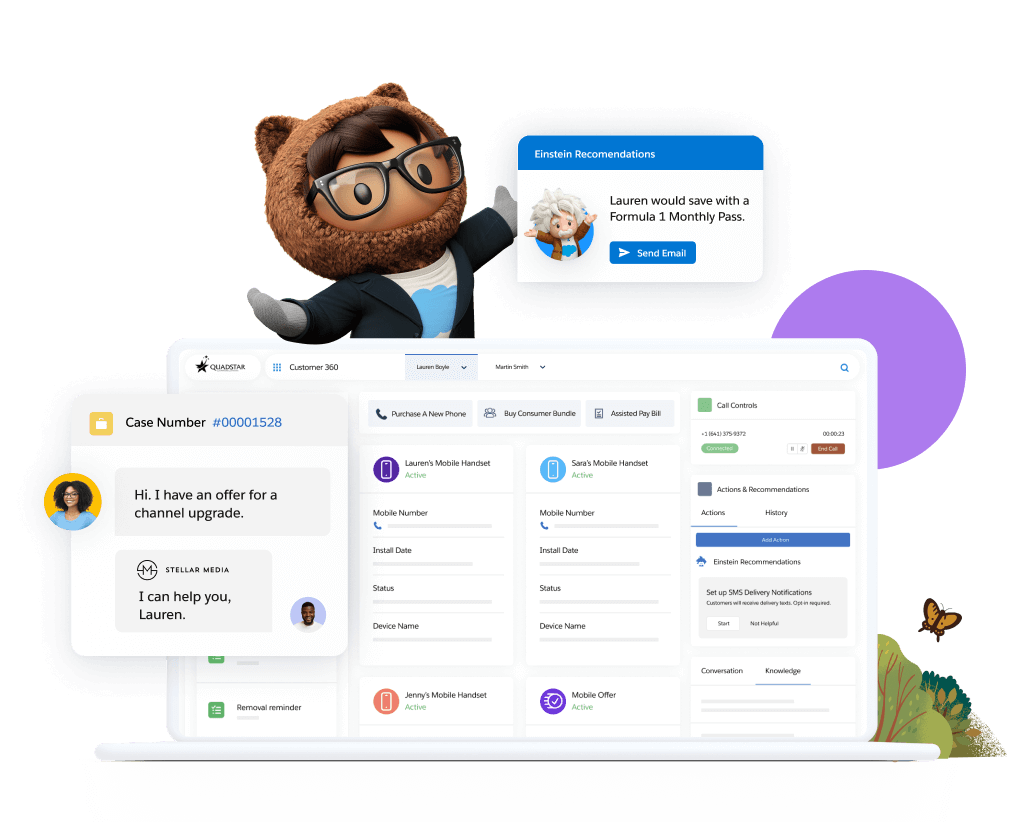Identifying the Right Time and Strategy
for Your Media Management Shift
As media companies strive to stay ahead of the curve in today’s dynamic landscape, identifying the right technologies to support growth is crucial. For many organizations, Boostr has served as a trusted partner, providing media-specific CRM and OMS capabilities to streamline operations. However, there often comes a point when a solution’s limitations begin hindering progress.
When this friction arises, it’s wise to re-evaluate your tech stack to ensure alignment with strategic goals. In our experience consulting with leading media enterprises, many outgrow Boostr as their needs become increasingly sophisticated. At this inflection point, migrating to a more scalable and customizable solution like Salesforce Media Cloud emerges as a compelling path forward.
In this article, we’ll examine the unique benefits Boostr offers media teams initially, common pain points that arise over time, and how Salesforce Media Cloud can address these limitations to unlock new levels of efficiency and innovation. For media companies feeling constrained by Boostr’s rigid structure, the flexibility of Salesforce Media Cloud represents a solution worthy of consideration.
Why Media Teams Adopt Solutions Like Boostr
With customer data, campaign metrics, and financial information flowing from every direction, media organizations require specialized systems to consolidate and extract value from their data. Purpose-built for the media industry, Boostr emerged as an end-to-end platform spanning the entire ad sales customer lifecycle, from planning to execution, billing and more. For many companies, Boostr delivered a turnkey CRM and OMS system with preset workflows mirroring their operational norms. With Boostr’s media-centric design, ad sales teams could access a centralized hub for managing initiatives while eliminating tedious manual processes. Leadership could leverage real-time dashboards to monitor performance, and sales professionals could view customer insights to drive targeted outreach. This integrated structure could enable improved collaboration and visibility organization-wide.
Additionally, Boostr’s focus on the needs of media enterprises allowed for efficient implementation and rapid time-to-value. For many companies, Boostr was able to fulfill their requirements splendidly in the early stages. However, over time, the very structure that provided initial efficiencies often began creating constraints for those very same companies.

Why Media Organizations Quickly Outgrow Solutions Like Boostr
While purpose-built systems allow for rapid deployment, their rigid frameworks often need more flexibility to adapt as businesses evolve. As organizations scale in size and complexity, they require solutions to keep pace with changing demands. Boostr’s infrastructure may strain under rising data volumes, user counts, and functionality needs of larger media firms. The system architecture that worked smoothly for a 50-person company can cripple a 500-person enterprise. As the number of attributes and overall line items associated to a single campaign multiply, Boostr lacks the horsepower to maintain performance. A design that once supported critical middle office workflows perfectly can quickly become constricting.
Boostr’s less flexible structure locks users into predefined processes that hinder the agility and customization media teams require as needs develop. While consolidating internal information, Boostr’s closed architecture can inhibit seamless integration with other systems, preventing a unified view across CRM, digital, financial, and other data sources. This results in decisions made in isolation and friction across departments. Licensing, implementation, maintenance, and training costs can become excessive for enterprises, especially when considering the need for custom development to enhance capabilities. The ROI on investment diminishes over time as teams outgrow the solution. Facing these pitfalls, media leaders rightfully begin re-assessing their technology environment. They realize that while point solutions deliver quick wins initially, modernizing core infrastructure positions organizations for sustained success.
A list of the top ten reasons why companies leave Boostr, in no particular order:
1. Limited scalability: Boostr may struggle to handle the increasing volume of data and complexity of operations as media companies scale.
2. Lack of customization: Boostr’s rigid design and architectural structure may struggle to adapt to the unique processes and evolving needs of every media company. The platform’s lack of customization could prove challenging for organizations looking to tailor it to their distinct workflows.
3. Integration challenges: Boostr may not integrate seamlessly with other enterprise systems, creating silos of data and hindering collaboration.
4. Hidden cost of ownership: While Boostr’s standard license fees may seem competitive, the total cost of ownership is often much higher than it initially appears. There are hidden costs that add up over time, so ad sales organizations need to account for these hidden costs when evaluating Boostr’s total cost of ownership.
5. Lack of innovation: Some users have complained that Boostr has not kept pace with the latest technological advancements in the media industry.
6. Limited customer support: Some Boostr clients have reported requiring more ongoing technical help to achieve their customer service goals, but have reported that timely support and help isn’t always available.
7. Limited reporting capabilities: Boostr’s reporting capabilities are limited and may need to be augmented with other solutions for the needs of many media companies.
8. Limited third-party integrations: Boostr’s limited third-party integrations may restrict media companies’ ability to connect with other key systems and tools in the ad sales tech stack.
9. Lack of transparency: Some users have cited that Boostr is not transparent about its pricing or product roadmap.
10. Lack of capabilities around handling different ad types: While Boostr has proven its ability to handle digital, it has limitations across other types of ad types, such as print, linear, and more.

Evaluating a Scalable Alternative – Salesforce Media Cloud
Transitioning to Salesforce Media Cloud offers media teams an opportunity to gain a flexible platform tailored to their unique needs and built to scale. Salesforce enables unparalleled customization, robust integration capabilities, and oftentimes, a lower total cost of ownership, positioning organizations for innovation and breakthrough performance levels. When evaluating alternatives, here are key advantages to consider with Salesforce Media Cloud:
- Salesforce’s cloud-native architecture provides nearly unlimited capacity to handle massive data volumes, user counts, and complexity. The platform effortlessly scales to support enterprise-wide processes and emerging needs.
- Salesforce’s component-based framework allows organizations to tailor solutions to ever-evolving workflows rather than forcing pre-defined processes.
- Teams gain the flexibility to modify and extend capabilities on-demand.
- With robust APIs and out-of-the-box connectors, Salesforce integrates seamlessly across technology stacks to provide a single source of truth. This expanded visibility enables improved collaboration and decision-making.
- The total cost of ownership with Salesforce can be lower compared to organizations leveraging Boostr due to the fact that Salesforce offers a full prospect-to-revenue reconciliation platform, simplifies the tech stack, and minimizes the need for integrations and/or “swivel-chair” efforts. Various pricing models provided by Salesforce can align costs to usage, allowing media teams to maximize value.
These advantages translate into tangible outcomes for media companies looking to advance. Let’s examine some of the benefits realized when teams make the shift.
Unlocking Growth and Efficiency with Salesforce Media Cloud
Transitioning to Salesforce Media Cloud empowers media teams with tools to drive greater success across key performance indicators. The platform accelerates processes, provides holistic insights, and allows personalization that delights customers. By automating redundant manual processes, Salesforce lets teams focus on higher-value activities, such as upselling and optimizing campaign performance.
Workflows become more efficient enterprise-wide. With data integrated from all departments and channels, organizations gain complete visibility into customer behavior and preferences. Salesforce enables tailoring interactions to customers based on their unique interests and history across touchpoints. Deeper analytics empower data-driven decision-making to optimize activities, channels, and spend. Salesforce creates new sales opportunities, nurtures prospects, and facilitates management of the entire customer lifecycle. Transitioning to Salesforce Media Cloud positions teams to thrive in evolving customer expectations and market dynamics.
Navigating Your Transformation Journey
When assessing if migrating from Boostr to Salesforce Media Cloud is the right move for your media organization, take a services-led approach:
- Clarify business objectives and requirements.
- Outline target processes, data models, integrations, and workflows.
- Quantify expected costs, benefits, risks, and timelines and perform a holistic pros/cons analysis, taking into consideration people, processes, platforms, and data.
- Build an implementation roadmap aligned to strategic goals.
- Select implementation and training partners to mitigate risk.
- Commence a phased rollout led by user feedback and adoption metrics.
- Measure ongoing success and refine the solution.
With this blueprint, you can ensure a smooth and effective transition to Salesforce Media Cloud, allowing your team to realize maximum value while minimizing disruption. And if you have a moment, take a look at this video featuring Salesforce’s Global Head Industry GTM, Candice Edwards, and V2’s Sr. Director of Industries, Joe Hooper, as they discuss why Media Cloud came to be and the many problems it solves for media organizations.
Building Trust Starts With A Conversation.
If you are exploring a migration from Boostr, our team at V2 Strategic Advisors is here to guide you. With decades of experience implementing Salesforce globally, we provide media companies with an objective perspective and proven methodology that can best set them up for success.
Please reach out to schedule a strategic no-cost consultation. The landscape ahead will reward media teams able to adapt quickly. Is your technology stack positioned to drive growth?


